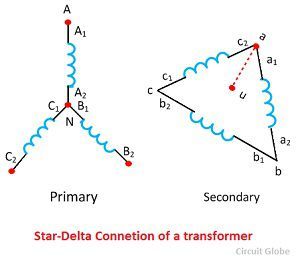AC MACHINES-1 (66761) Theory
7. Realize the construction and Principle of operation of three phase transformer.
7.3. Describe the methods of star–star, delta–delta, star–delta and delta–star connection.
1. DELTA-DELTA (Δ-Δ) CONNECTION
The delta-delta connection of three identical single phase transformer is shown in the figure below. The secondary winding a1a2 is corresponding to the primary winding A1A2, and they have the same polarity. The polarity of the terminal a connecting a1 and c2 is same as that connecting A1 and C2. The figure below shows the phasor diagram for lagging power factor cosφ.

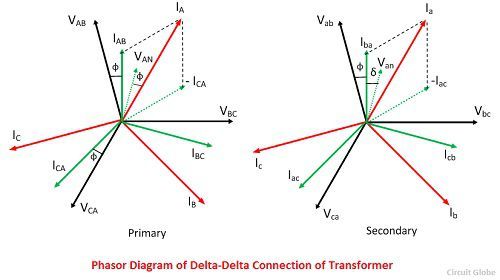
The magnetising current and voltage drops in impedances have been neglected. Under the balanced condition, the line current is √3 times the phase winding current. In this configuration, the corresponding line and phase voltage are identical in magnitude on both primary and secondary sides.
The secondary line-to-line voltage is in phase with the primary line-to-line voltage with a voltage ratio equal to the turns ratio.
If the connection of the phase windings is reversed on either side, the phase difference of 180° is obtained between the primary and the secondary system. Such a connection is known as an 180º connection.
The delta-delta connection with 180º phase shift is shown in the figure below. The phasor diagram of a three phase transformer shown that the secondary voltage is in phase opposition with the primary voltage.
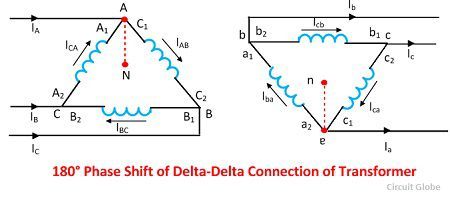
The delta-delta transformer has no phase shift associated with it and problems with unbalanced loads or harmonics.
ADVANTAGES OF DELTA–DELTA CONNECTION OF TRANSFORMER
The following are the advantages of the delta-delta configuration of transformers.
- The delta-delta transformer is satisfactory for a balanced and unbalanced load.
- If one transformer fails, the remaining two transformers will continue to supply the three-phase power. This is called an open delta connection.
- If third harmonics present, then it circulates in a closed path and therefore does not appear in the output voltage wave.
The only disadvantage of the delta-delta connection is that there is no neutral. This connection is useful when neither primary nor secondary requires a neutral and the voltage are low and moderate.
2. STAR-STAR (Υ-Υ) CONNECTION OF TRANSFORMER
The star-star connection of three identical single phase transformer on each of the primary and secondary of the transformer is shown in the figure below.The phasor diagram is similar as in delta-delta connection.
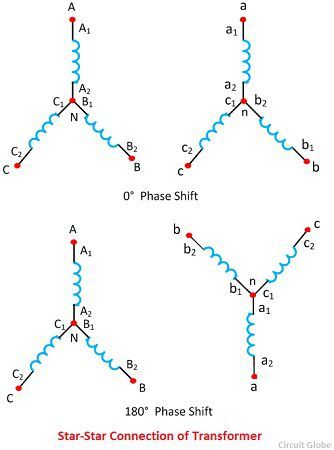
The phase current is equal to the line current, and they are in phase. The line voltage is three times the phase voltage. There is a phase separation of 30º between the line and phase voltage.The 180º phase shift between the primary and secondary of the transformer is shown in the figure above.
PROBLEMS ASSOCIATED WITH STAR-STAR CONNECTION
The star-star connection has two very serious problems. They are
- The Y-Y connection is not satisfactory for the unbalance load in the absence of a neutral connection. If the neutral is not provided, then the phase voltages become severely unbalance when the load is unbalanced.
- The Y-Y connection contains a third harmonics, and in balanced conditions, these harmonics are equal in magnitude and phase with the magnetising current. Their sum at the neutral of star connection is not zero, and hence it will distort the flux wave which will produce a voltage having a harmonics in each of the transformers
The unbalanced and third harmonics problems of Y-Y connection can be solved by using the solid ground of neutral and by providing tertiary windings.
3. DELTA-STAR (Δ-Υ) CONNECTION
The ∆-Y connection of the three winding transformer is shown in the figure below. The primary line voltage is equal to the secondary phase voltage. The relation between the secondary voltages is
VLS= √3 VPS.
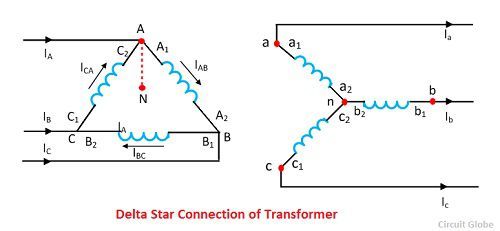
The phasor diagram of the ∆-Y connection of the three phase transformer is shown in the figure below. It is seen from the phasor diagram that the secondary phase voltage Van leads the primary phase voltage VAN by 30°. Similarly, Vbn leads VBN by 30º and Vcn leads VCN by 30º.This connection is also called +30º connection.
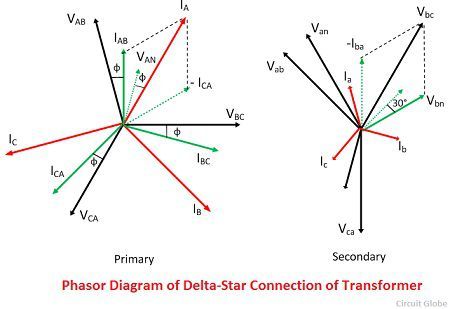
By reversing the connection on either side, the secondary system voltage can be made to lag the primary system by 30°. Thus, the connection is called -30° connection.
4. STAR-DELTA (Υ-Δ) CONNECTION
The star-delta connection of three phase transformer is shown in the figure above. The primary line voltage is √3 times the primary phase voltage. The secondary line voltage is equal to the secondary phase voltage. The voltage ratio of each phase is


Therefore line-to-line voltage ratio of Y-∆ connection is

The phasor diagram of the configuration is shown in the figure above. There is a phase shift of 30 lead exists between respective phase voltage. Similarly, 30° leads exist between respective phase voltage. Thus the connection is called +30º connection.
The phase shows the star-delta connection of transformer for a phase shift of 30° lag. This connection is called – 30° connection. This connection has no problem with the unbalanced load and thirds harmonics. The delta connection provided balanced phase on the Y side and provided a balanced path for the circulation of third harmonics without the use of the neutral wire.
